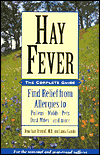
The traditional treatment used for colds—inhaling steam—can be very effective in hay fever. Use a mixing bowl from the kitchen, pour in boiling water, put a towel over your head and shoulders, and sit with your face over the bowl so that you are inhaling the steam. The longer you continue with this, the more effective the treatment will be. You may need to replace the water as it cools.
Essential Oils as Decongestants
Menthol, eucalyptus, and other essential oils with a decongestant action are sometimes added to the hot water to improve its effects. They can be bought from most health food stores or pharmacies. You could try adding these, but stop using them if there seems to be any irritation to the nose.
There are now various steam-inhalation devices for sale that achieve much the same thing as the old-fashioned bowl of hot water and towel treatment.
TREATMENTS TO REDUCE THE ALLERGIC RESPONSE
Research has shown that breathing hot humid air doesn't just help unblock the nose, it also reduces the reaction that occurs when an allergen enters the nose. Exactly how it does this is unknown, but scientists have found out that just warming up the membranes of the nose has a good effect, making the nose far less sensitive to its allergens.
Decongesting with Feet in Hot Water
So how do you warm the membranes in your nose? Well, it might sound strange, but you put your feet in a bowl of warm water. Medical scientists at the University of Chicago had one group of hay fever sufferers sit with their feet in hot water for 5 minutes; another group sat with their feet in water that was at room temperature. Then they inserted pollen allergens into their noses (it wasn't pollen season at the time). The ones with warm feet sneezed only half as much and produced far less mucus than the others.
What on earth would make scientists try such a weird experiment in the first place? In fact, they already knew that warming the feet increases the temperature of the blood in the nose without substantially increasing overall body temperature.
If you have ragweed allergy, the idea of putting your feet in a bowl of hot water on a sweltering August day probably isn't that appealing, but people with allergies to tree pollens, which get airborne in early spring, might just find this esoteric piece of research useful. Of course, you can't sit with your feet in hot water all day, but you could buy some thermal socks or fur-lined boots and see if the spring sneezes abate.
Salt Water Nose Drops
Saltwater nose drops can also be useful in relieving congestion a little and soothing the irritated membranes of the nose. Sterile saltwater (or saline) solution can be purchased at any pharmacy. You can also buy a dropper bottle, the lid of which contains a dropper for placing the saltwater drops in the nose. Fill the bottle with the salt water and change it every few days. Use the drops as often as you feel you need them.
Vitamin C Nose Drops
Nose drops containing vitamin C have been tried out by doctors in Israel, who tested them against placebo drops. They noted that the secretions of the nose are normally very slightly acidic, but that during a bout of rhinitis they become very slightly alkaline. It therefore occurred to them to try reversing this effect using a mildly acidic solution of vitamin C. About three-quarters of the patients tested experienced some benefit from these drops. Unfortunately, the concentration of vitamin C used in these tests was not reported.
If you would like to try this treatment, start with a very dilute solution—a quarter of a teaspoon of pure vitamin C powder in a pint of water. Should there be no beneficial effect, slightly increase the amount of vitamin C used—but if it stings, the solution is too concentrated. The water used should be boiled for at least 20 minutes beforehand to kill bacteria. Alternatively, buy purified water from a pharmacist.
As with saltwater drops, buy a small dropper bottle to contain the solution you have prepared and refill with fresh solution every few days. The drops should be used three times daily. Stop using the drops if you have a cold or other infection in the nose.
Getting Rid of Nasal Congestion
Medical researchers in Spain tried simply flushing pollen out of the nose with salt water. Hay fever sufferers were asked to irrigate their noses three times a day, for 4 to 5 minutes each time, using a special device called a Water Pik, which forces a pulsating stream of salt water into one nostril and out of the other. They continued with this for eight weeks, throughout the grass pollen season. Rather than asking the patients how they felt, the researchers actually looked at the levels of IgE (the allergy antibody) in the blood to see what effect the nose-wash treatment was having. Sure enough, with the onset of the grass pollen season, IgE levels began to rise steeply in the control group (no treatment apart from their usual drugs) while those using the saltwater treatment (plus their usual drugs) showed a much more modest increase in IgE.
Article Source:

Hay Fever, ©1993,2002
by Dr. Jonathon Brostoff & Linda Gamlin.
Reprinted with permission of the publisher, Healing Arts Press. www.InnerTraditions.com
About the Authors
Jonathan Brostoff, M.D., is Professor Emeritus of Allergy and Environmental Health at King's College in London and an internationally recognized authority on allergies.
Linda Gamlin was trained as a biochemist and worked in research for several years before turning to scientific writing. She specializes in writing about allergic diseases, the effects of diet and the environment on health, and psychosomatic medicine. Together they have coauthored Food Allergies and Food Intolerance and Asthma.



























